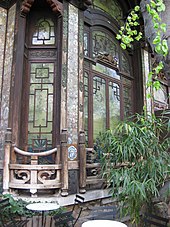
Back التأثير الياباني Arabic Japonisme Catalan Japonismus Czech Японизм CV Japonisme Danish Japonismus German Ιαπωνισμός Greek Japanismo EO Japonismo Spanish ژاپنیسم FA

Japonisme[a] is a French term that refers to the popularity and influence of Japanese art and design among a number of Western European artists in the nineteenth century following the forced reopening of foreign trade with Japan in 1858.[1][2] Japonisme was first described by French art critic and collector Philippe Burty in 1872.[3]
While the effects of the trend were likely most pronounced in the visual arts, they extended to architecture, landscaping and gardening, and clothing.[4] Even the performing arts were affected; Gilbert & Sullivan's The Mikado is perhaps the best example.

From the 1860s, ukiyo-e, Japanese woodblock prints, became a source of inspiration for many Western artists.[5] These prints were created for the commercial market in Japan.[5] Although a percentage of prints were brought to the West through Dutch trade merchants, it was not until the 1860s that ukiyo-e prints gained popularity in Europe.[5] Western artists were intrigued by the original use of color and composition. Ukiyo-e prints featured dramatic foreshortening and asymmetrical compositions.[6]
Japanese decorative arts, including ceramics, enamels, metalwork, and lacquerware, were as influential in the West as the graphic arts.[7] During the Meiji era (1868–1912), Japanese pottery was exported around the world.[8] From a long history of making weapons for samurai, Japanese metalworkers had achieved an expressive range of colours by combining and finishing metal alloys.[9] Japanese cloissoné enamel reached its "golden age" from 1890 to 1910,[10] producing items more advanced than ever before.[11] These items were widely visible in nineteenth-century Europe: a succession of world's fairs displayed Japanese decorative art to millions,[12][13] and it was picked up by galleries and fashionable stores.[7] Writings by critics, collectors, and artists expressed considerable excitement about this "new" art.[7] Collectors including Siegfried Bing[14] and Christopher Dresser[15] displayed and wrote about these works. Thus Japanese styles and themes reappeared in the work of Western artists and craftsmen.[7]
Cite error: There are <ref group=lower-alpha> tags or {{efn}} templates on this page, but the references will not show without a {{reflist|group=lower-alpha}} template or {{notelist}} template (see the help page).
- ^ "Japonism". The Free Dictionary. Retrieved 7 June 2013.
- ^ "Commodore Perry and Japan (1853–1854) | Asia for Educators | Columbia University". afe.easia.columbia.edu. Retrieved 2020-02-02.
- ^ Ono 2003, p. 1
- ^ Davis, Aaron, "Japanese Influence On Western Architecture Part 2: The Early Craftsmen Movement" Nakamoto Forestry, May 28, 2019; accessed 2020.09.16.
- ^ a b c Bickford, Lawrence (1993). "Ukiyo-e Print History". Impressions (17): 1. JSTOR 42597774.
- ^ Ono 2003, p. 45
- ^ a b c d Irvine 2013, p. 11.
- ^ Earle 1999, p. 330.
- ^ Earle 1999, p. 66.
- ^ Irvine 2013, p. 177.
- ^ Earle 1999, p. 252.
- ^ Irvine 2013, pp. 26–38.
- ^ Earle 1999, p. 10.
- ^ Irvine 2013, p. 36.
- ^ Irvine 2013, p. 38.